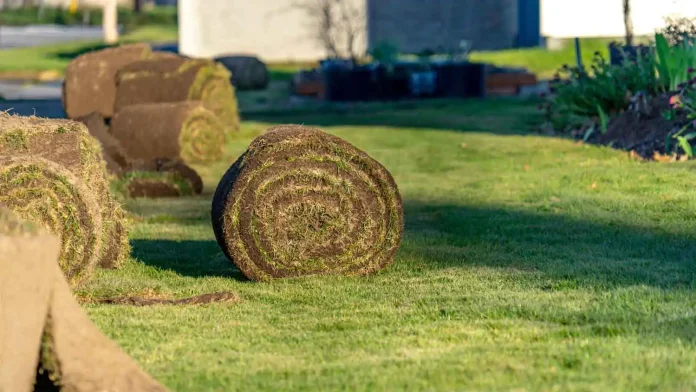In today’s time, farmers can increase their income by cultivating other commercial crops along with traditional farming. In this episode, today we will discuss the cultivation of sod grass, a similar commercial crop. Sod grass, also known as turf, is the top layer of soil on which grass grows, often harvested in rolls. Sod is commonly used for lawns, golf courses and sports stadiums around the world. But nowadays, by using this grass in parks and gardens while constructing houses, we can grow grass in our parks in less time, and this grass is also useful in preventing soil erosion. In our country, the demand for this sod grass is high in the market, and it is cultivated in fewer areas. Due to this, farmers can earn good profits from sod grass cultivation.
Requirements For Sod Grass Cultivation
Suitable Soil In Sod Grass Cultivation
While cultivating sod grass, sandy loam soil is required for its crop to grow well. Sod grass is cultivated on flat land. It is very difficult to harvest its crop because this grass becomes very heavy in weight when wet and very hard when dry. That’s why the land should be flat or wavy to cultivate it.
Preparing The Field For Sod Grass Cultivation
Before cultivating sod grass, the soil of the field should be ploughed well, and the pebbles and vegetation should be cleaned from the field. For this, the field should be ploughed 3 to 4 times with the help of a plough operated by the Swaraj 744 tractor. Next, a layer of compost is spread to fertilise the soil with the nutrients needed for turf to grow well. The land is then ploughed to mix the manure in a well, and the existing soil is further loosened and pulverised. It is vital to ensure that it is cultivated in a flat field only. Suppose you attempt to cultivate sod grass on an uneven surface. In that case, this will cause problems when you irrigate the grass, as pooling will occur in some areas, allowing excess water to accumulate in the grass, making the grass prone to rotting.
Caring In Sod Grass Cultivation
Sod grass is sown by means of seeds. Then, it is transplanted by the hybrid springs method. Once the seed is sown, it can take anywhere from 10 months to two years to cultivate turf before it is ready for harvest. In its crop, the plant has to be watered at regular intervals, and grass pruning has to be done from time to time. While cultivating it, fertiliser management also has to be done for the good development of the plant in the field.
Harvesting Of Sod Grass
Some things have to be kept in mind while harvesting this grass, and these things are as follows-
- Make sure to irrigate the field 24 to 48 hours before mowing. This will moisten the soil in the field, making it easier for the sod cutter to do its job.
- Dry soils result in problems such as blade slippage, poor cutting of the sod, etc. Also, handling the sod cutter becomes a difficult task.
- To cut the grass, water must be given 1 or 2 days before cutting the grass.
- To cut this grass, cut the sod grass with at least 2 to 2.5 cm of topsoil.
- Harvesting at this depth creates a level ground for future sowing.
- Sad grass also reduces the roots of grass and weeds from the field. It also prevents grass and weeds from re-growing.
Investment In Sod Grass Farming
Starting a farm for cultivating sod grass requires a good investment. To build a sod farm, good equipment is needed to prepare the field, which costs a lot. Necessary equipment to cultivate sod grass are sod cutters, tractors, ploughs, skid steer loaders, planting drills, mowers, fertiliser spreaders, rollers and tractors for delivery, such as the Massey tractor 241 because the Massey tractor 241 price is reasonable. Equipment like sprinklers are also required to irrigate the crop. To cultivate it commercially, experts and skilled labour are also needed.
Benefits Of Sod Grass Cultivation
Sod grass cultivation has many advantages. Its crop does not require intensive irrigation. Sod grass can be transplanted at any time in any season. Compared to the grass sown directly in the field, it develops quickly, and the grass’s chances of spoilage are very low. Its cut grass also prevents infestation by snakes and other small insects. The environmental benefit of this grass is that this turf grass forms a soil cover, which helps the soil prevent erosion from both wind and water. In addition, during photosynthesis, it releases a large amount of oxygen gas.
Conclusion
In this way, we have given you all the essential information about the cultivation of Sod grass. We hope this blog will solve all your concerns regarding the planting, caring and harvesting of Sod grass. For more such blogs about profitable farming trends, stay connected with us.





